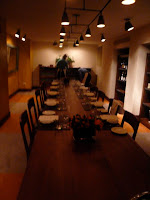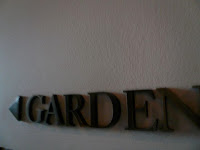From the moment you turn the corner and experience the undulating boxwood garden border fronting the entire block of the Gramercy Park Hotel (www.gramercyhotel.com) you are transported.
I was reminded of the opening scenes of “The English Patient” where the screen is filled with sensuous, undulating, curving landscapes. Never mind that the movie focus was of sand dunes.
To my mind’s eye, the elegant spare landscape of that cinemascope was the artistic twin to this Gramercy Park Hotel urban landscape. (Planted in just 12 inches of soil I learned later.)
And this was just foreplay! The real piece de resistance is the roof top landscaped garden.
With heightened anticipation, I entered the lobby of the hotel not for the first time.
But with a different purpose.
I was meeting Lynn Torgerson (www.lynntorgersongardens.com), the garden designer for the hotel’s front border garden and its roof top terrace garden.
At a recent MetroHort event, Lynn invited me to visit the garden. I love this hotel and had wanted to see the celebrated roof top garden for some time but the stars were never aligned.
Gramercy Park is Ian Schrager’s luxury Hotel in New York City’s Union Square area. The art collection that adorns the colossal walls is sensuous and commanding. The room lobby and bar look like a castle, albeit a glamorous sexy one – with sparkling chandeliers, bold red carpets, sumptuous velvet furniture and heavy drapes, cavernous fireplaces and sweet, sultry scented candles seemingly everywhere.
I had graciously accepted Lynn’s kind offer, saying spring wasn’t toooo far away.
Not pausing, Lynn said, “Come anytime.” Sensing a slight faux pas or egads, a missed trick on my part, I squinted a follow up. “What do you mean, anytime?”
She reiterated. “Anytime.”
Hmmm. Now I’ve got to ask. “I thought it was a rooftop garden?” With great patience she nods. “It is.” Pause. “But it’s all enclosed in the winter – so anytime you want to come, it’s good.”
Winning the lottery can’t feel as good. J
I think seeing a garden like this in winter makes it even more special than if I experience it when everything around is green too.
So now this all gets even better than I had hoped.
Come on – when all is cold and grey to others (I like the city in winter, thank you very much) but I am privy to a warm garden with iconic views of Gotham—be still my beating heart!
We agree to a scheduled date. Follow up will happen. But we have a plan.
Carpe diem!
The day of the planned tour, I am inspired to email Roberta, the unparalleled floral designer for Danny Meyers’s restaurant empire. Danny’s latest restaurant is the Tuscan inspired Maialino

which is seemingly part of the Gramercy Hotel and in fact, occupies the space next door and yet is still attached. (Don’t ask – just go!)
More serendipity as Roberta has agreed that -- with relatively no notice – she can do it!
I met Roberta when we were photographing Chef Michael Anthony at Gramercy Tavern restaurant – another shining star in Danny Meyers’ restaurant portfolio.
I was there because of a photo shoot for my book about master chefs and their gardens.
My photographer, Jennifer Calais Smith (www.jennifercalais.com) and food stylist, Patty White (www.pattywhitefoodstylist.com) were working with me to photograph Chef Michael’s amazing culinary art.
At the same time, I couldn’t help be drawn to the floral design compositions that Roberta was divining and arranging.
I had to include her in the book! Chef Michael agreed as did my editor, Kari.
When you visit any of Danny Meyers’s restaurants, please let me know how much you love Roberta’s amazing interior garden designs.
She is an artist.
So the evening of the first rooftop garden tour, I was looking forward to great interior garden design AND great exterior garden design.
And to seeing and having networked two amazing plant women.
Oh, and I forgot to mention that I was meeting a former colleague and friend, Joanne Trout, who was treating me to a birthday dinner at Maialino restaurant. Maialino is Myers’ latest culinary tour de force. Maria, my garden design client and Italian language linguist told me maialino means “little pig.” How cute!
It just doesn’t get any better :)
Maialino is located just to the downtown side of the hotel. As a guest, you’d think they are part of the same establishment.
Roberta took us on a quick tour of the restaurant. We could better appreciate its simple, elegant yet casual environment – punctuated by Roberta’s floral designs.
Private dining room and Roberta's floral creations
Cuccina:
Well, we were drinking our Prosecco and Roberta and Lynn were having such a good time getting to know one another --- and I was enjoying it all.
Yet, as a garden sprite, I knew we had to get to that roof. There wasn’t much winter daylight left…
A tad late, we hop in the special elevator transporting us up 16 floors to the Hotel Rooftop Bar – a Private Club and Garden. Only members are admitted to this level so I’m feeling very VIP.
Like a Broadway stage whose curtains rise to reveal a carefully crafted other world of make-believe, the elevator doors opened to reveal a magical garden in the sky.
The anticipation matches the reality.
This garden is a fantasy. A dream.
It was dusk. The sky was pink. The nearby skyscrapers loomed as architectural sentinels. All this drama was mere backdrop for the garden at Gramercy Park Hotel.
There, the entire length of the garden sparkled with tiny white lights on the ceiling, peeking through the green overhead and on the shrubs and trees in containers bordering the garden walls.

As we walked, I was awestruck. My head was like a scope – turning upwards – left and right – all the while listening to Lynn describe the design work and maintenance that is integral to this unique garden.
I defy anyone, of any age, to not be rendered speechless by this garden.
It has the magic of Disney, of countless movies of Manhattan, and is a gardener’s dream world. We gardeners can appreciate the design and work that goes into a living room such as this.
For everyone else, the garden embraces you in a very intimate way and stimulates the senses. This is especially so on a winter day simply because it’s a paradox. But Lynn has made this impossibility just so natural.
The garden wraps around three sides of the building. In the warmer weather, the hotel has the option to open up part of the glass roof, or all or provide an awning to cover part of the garden in the sky to block the sun with the use of the retractable roof.
When I was the Director of Communications at a major NYC botanic garden, I had recommended Lynn to New York Magazine as the ideal candidate to redesign NYC’s marriage bureau. She nailed it: http://tinyurl.com/yjsdh9s
Sexy too, no?
Here at the Gramercy Park Hotel, Lynn’s brilliant work is not only on display in the design, but in the ongoing maintenance. As you can image, it’s not in the least bit easy to keep up a good garden considering the inhospitable conditions. There is the weather to consider of course and on a roof top terrace, weather can be extreme. In addition, because it’s club, guests often “see” the plants as backdrop and don’t always treat them with great care, resulting in glasses in the pots or broken branches…
Her team is there two times a week – at a minimum.
“I want perfection,” Lynn said, not surprisingly. They over-service their clients here – as elsewhere -- because they love their work and have a passion for the plants.
The garden was launched in 2006. Lynn and her team designed the container garden to adhere to owner Ian Schrager’s fondness for Italian gardens. The miracle on the roof is that with a series of containers, fruit trees, fragrant vines, including jasmine, ficus plants, palms, dracenas, ferns of all kinds and overhead silk leaves, Lynn captured the look and feel of the beauty of Rome or Tuscany. “I wanted a lot of citrus plants to really get the feel of an Italian garden,” Lynn explained.
She was also able to use a lot of red color - prized by owner Schrager – even down to a red furniture composition.
Keen gardeners will want to know how all this green beauty is achieved and maintained – on a budget.
Lynn chose containers that are lightweight; some of the seemingly hundreds of planters are fiberglass and zinc.
The quality is terrific – the pots look like terracotta or the real deal, there is no doubt.
Lynn noted she sourced most of the containers from Evan Peters & Co., direct importers of garden pottery and are located in Long Island City http://tinyurl.com/ykym96o
Lynn had to establish a formal watering system and so installed a drip design for the containers. In addition, the team supplements the irrigation systems and does hand watering too.
In terms of pest control, they employ an integrated pest management (IPM) approach because it’s the smart way to do it and also, this is a dining area.
Even though there can be lots of wind in the summer, Lynn has positioned pots of plants all along the windowsills – in fact, she changes them out with the seasons—usually every six months. She loves the kalanchoes for their red color (a nod to the client) and for their water-wise needs.
Under extraordinary conditions, Lynn has employed a variety of plants, containers, and elegant garden design to create a sustainable, intoxicating garden.
This is a seductive, mysterious world that Lynn has created – from traditional ladybugs and green plants, to the urbane, sophisticated “Lady Bugs" ^:^ and their escorts = quintessential New Yorkers and urbane tourists enjoying nature, seen poised throughout the garden terrace’s stylized conversation compositions – or as Schrager describes it, “lobby socializing.”
This chandelier is the size of the room it adorns and is breathtaking.
Roberta (left) and I are dazzled by the light!
Because our first garden tour was abbreviated due to diminishing daylight, I asked Lynn if we could come back. I also wanted to share the garden tour with EunYoung Sebazco, Duchess Designs’ lead horticulturist and extraordinary garden designer and Randall’s Island park manager. Lynn agreed.
The garden is just as exhilarating in the daylight.
The perfect finish on the second garden tour a week or so later was to enjoy the glamorous garden – with an herbal cocktail.
I had the Ginger Fig: vodka with muddled ginger root, fig jam and fresh orange juice. Lynn & EunYoung enjoyed the Rose & Lychee Martini: Hendricks gin (which if you don’t know is made with roses – member of the cucumber family), rose syrup, fresh muddles blackberries and a touch of coconut.
Aren’t plants the best? We can sit among them enjoying their beauty and fragrance and drink a plant-filled ambrosia.
A heavenly experience. Especially being that much closer to the clouds…
Oh, and when I wanted to add Lynn’s web site to this blog post, I Googled her business and guess what?
The Google pin indicated Lynn Torgerson’s garden design business – and curiously, made it appear for the entire world like it is located directly at the Museum of Sex! Coincidence? With all the sensual garden design I saw at Gramercy Park Hotel, I don’t think so.
 Lynn - oh so elegant with fabulous garden footwear!
Lynn - oh so elegant with fabulous garden footwear!Gramercy Park Hotel
2 Lexington Avenue, NYC 10010
212-920-3300
Check out the visual images slide show – next best thing to being there.
Maialino, a Roman Trattoria at Gramercy Park
2 Lexington Avenue, NYC 10010
212-777-2410







































